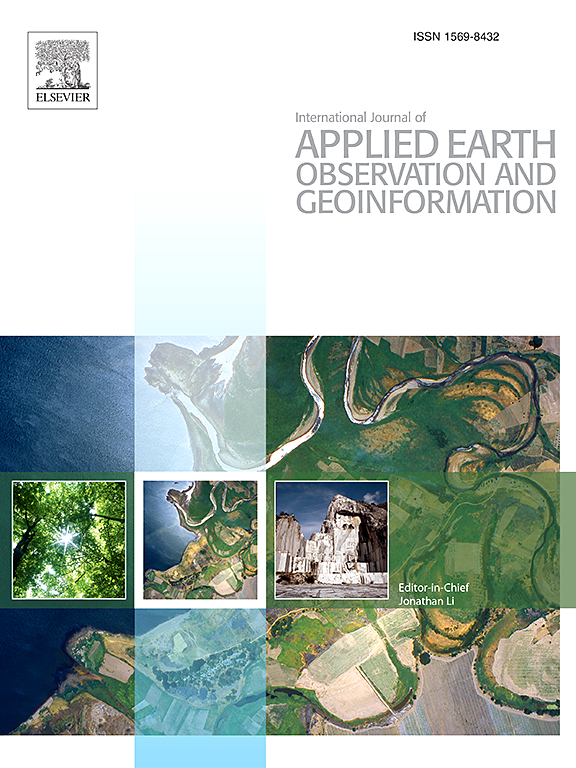Fusing multiplatform topo-bathymetric point clouds based on a pseudo-grid model: A case study around Ganquan Island, South China sea
IF 7.6
Q1 REMOTE SENSING
International journal of applied earth observation and geoinformation : ITC journal
Pub Date : 2025-03-26
DOI:10.1016/j.jag.2025.104492
引用次数: 0
Abstract
High-quality, full-coverage topographic bathymetric data is crucial for marine economic development and ecological environment protection. Due to the complex environment of land-sea transition zone, it is challenging to acquire comprehensive bathymetric topography using a single sensor. Multiplatform topographic bathymetric technology, such as airborne LiDAR bathymetry (ALB) and multibeam echo sounding (MBES), whose point clouds can be integrated to construct a complete model of land-sea transition zone. However, point cloud data from different sources may have certain differences in the digital description of the same target. Meanwhile, affected by factors such as registration error and sensor system error, there are data gaps in the registered point cloud, which hinders the subsequent reconstruction. To overcome these problems, a fusion method combining a pseudo-grid model is proposed to construct a high-quality, seamless topographic-bathymetric map. This paper’s contribution identifies non-overlapping ALB regions and generates anti-noise MBES simulated points (SPs) by constructing a pseudo-grid. Moreover, this paper focuses on establishing a point-to-SP model to eliminate the gaps and reduce the impact of registration errors on the fusion accuracy. To verify the effectiveness of the proposed method, four typical samples along with six reference samples exhibiting diverse features collected from Ganquan Island in the South China Sea are utilized in the experiment. The results show that the proposed algorithm can achieve ideal results in terms of the average root mean square error (RMSE) of the six reference samples, which is reduced from 0.41 m to 0.19 m. It is indicated that the true topography can be restored and the proposed method has advantages in accuracy and robustness.
基于伪网格模型的多平台地形-测深点云融合:中国南海甘泉岛周边案例研究
高质量、全覆盖的地形水深数据对海洋经济发展和生态环境保护至关重要。由于海陆过渡带环境复杂,单传感器获取综合水深地形具有一定的挑战性。多平台地形测深技术,如机载激光雷达测深(ALB)和多波束回波测深(MBES),其点云可以集成,以构建完整的陆-海过渡区模型。然而,不同来源的点云数据对同一目标的数字描述可能存在一定的差异。同时,受配准误差和传感器系统误差等因素的影响,配准后的点云存在数据缺口,阻碍了后续的重建。为了克服这些问题,提出了一种结合伪网格模型的融合方法来构建高质量、无缝的地形图。本文的贡献是通过构造伪网格来识别非重叠的ALB区域并生成抗噪声MBES模拟点(SPs)。此外,本文还重点建立了点到sp模型,以消除间隙,降低配准误差对融合精度的影响。为了验证该方法的有效性,在南海甘泉岛采集了4个典型样本和6个具有不同特征的参考样本进行了实验。结果表明,该算法对6个参考样本的平均均方根误差(RMSE)从0.41 m减小到0.19 m,取得了理想的效果。结果表明,该方法可以恢复真实地形,具有精度高、鲁棒性好等优点。
本文章由计算机程序翻译,如有差异,请以英文原文为准。
求助全文
约1分钟内获得全文
求助全文
来源期刊

International journal of applied earth observation and geoinformation : ITC journal
Global and Planetary Change, Management, Monitoring, Policy and Law, Earth-Surface Processes, Computers in Earth Sciences
CiteScore
12.00
自引率
0.00%
发文量
0
审稿时长
77 days
期刊介绍:
The International Journal of Applied Earth Observation and Geoinformation publishes original papers that utilize earth observation data for natural resource and environmental inventory and management. These data primarily originate from remote sensing platforms, including satellites and aircraft, supplemented by surface and subsurface measurements. Addressing natural resources such as forests, agricultural land, soils, and water, as well as environmental concerns like biodiversity, land degradation, and hazards, the journal explores conceptual and data-driven approaches. It covers geoinformation themes like capturing, databasing, visualization, interpretation, data quality, and spatial uncertainty.
 求助内容:
求助内容: 应助结果提醒方式:
应助结果提醒方式:


